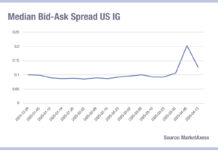The International Capital Markets Association (ICMA) has published a report outlining the possible routes to delivering a successful consolidated tape of price data of the fixed income markets in Europe. The post-trade consolidated tape should aim to “provide a comprehensive, detailed, accurate and meaningful view of where, when and how all price forming trades occurred.”
A consolidated tape of the equity markets was recommended in the 2011 review of the first Markets in financial Instruments Directive (MiFID) implementation and relied on an unprecedented commercial offering to materialise. That approach failed.
By contrast the US began rolling out a post-trade pricing tape for fixed income, the Trade Reporting and Compliance Engine (TRACE), in 2002. That is managed by a trade association that acts as an industry-led regulatory body, the Financial Industry Regulatory Authority (FINRA), a group set up to represent banks and dealers.

“In order to determine the best governance model for the consolidated tape provider (CTP) and consolidated tape (CT) operation, it is necessary to assess the likelihood of the CTP becoming a successful ‘going concern’,” wrote Elizabeth Brooks Callaghan (ICMA), report author and director, secondary markets at ICMA. “This involves assessing potential funding, stewardship, management structure and IT operation models.”
The possible models are outlined in the paper, which was compiled by the ICMA’s CT Taskforce, a collection of representatives from 36 industry practitioners, with the perceived positives and negatives of each model and views given by the Taskforce members as ot the probability of success.
According to ICMA’s CT Taskforce, there are potential governance model options which could deliver a CT for EU bond markets, but require decisive strong EU leadership “and the will to surmount any associated negative of relevant option models”. The models are:
• A limited company working with the European Securities and Markets Authority (ESMA) in a close public- private partnership with outsourced IT operations, could take out a loan to be paid back on a cost recovery basis from user fees, to provide a CTP;
• ESMA could govern through an SRO data entity mechanism. Recovering costs through subscription/membership fees to provide a CTP;
• ESMA could work with the industry (stewarding day- to- day operations) but have overall governance, recovering costs through NCA increased contributions, to provide a CTP;
• APAs could converge on technical standards and a single business model, recovering costs through industry accepted user fees, in order to work together to provide a CTP;
The paper recommends that it is mandatory that trading venues and trading data reporting mechanisms provide data to the CTP, in level one text of the MiFID II/R legislative framework, that part written by the European Commission, and extended to self-reporting firms. Use of the data should not be obligatory, with an understanding that price is only one component of execution quality.
Revenue sharing for data reporting mechanisms and trading venues is recommended in the paper to create timely and reliable post-trade data, with revenue derived via a ‘data quality score card’ proportionate to the volume of data provided by the contributing firm and penalties considered such as withholding the revenue ‘share’.
A review of the scheme is suggested after the first five years to assess if the revenue sharing scheme should be extended, continue as a permanent scheme or whether it should end.
The report says the CTP should collect the raw data and make it available to all market participants, through a minimum-cost model. The second Markets in Financial Instruments Directive (MiFID II), which came into effect on 1 January 2018, only established the provisions for a consolidated tape provider (CTP) for non-equity markets from 1 September 2019. The Directive provides for a review provision for the non-equity consolidated tape (CT) under Article 90(2) of MiFID II, and the EC is required to present a report on the non-equity CT to the Council and the European Parliament by 3 September 2021.
©Markets Media Europe 2025


























